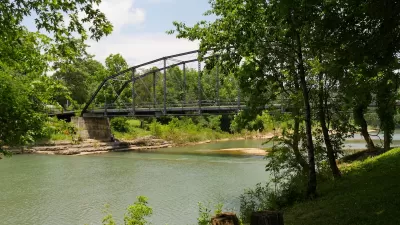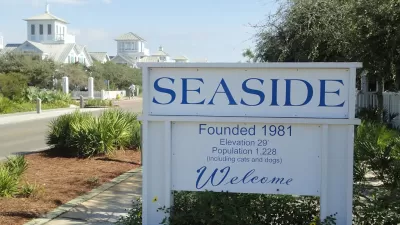Terrain.org takes a look at Plum Creek, a New Urbanist development outside Austin, TX that added 1,400 households to a town that had only 4,000 people in the mid-1990s.
"New urbanism provided the framework for the community design, and making the project affordable remained a driving force for the team. By developing in Kyle, the project would have a price advantage over Austin, and the goal of creating a place for a variety of people where home prices started in the $100,000s instead of the $400,000s remained primary throughout the planning and development process.
As is often the case for New Urbanism and smart growth communities, the desired lot sizes, street widths, mix of uses, and numerous other aspects proposed by the developer were not allowed under the City of Kyle's existing residential subdivision code. Benchmark spent 18 months negotiating a detailed planned unit development (PUD) agreement with the city. Sidewalks, planting strips, and street trees are part of Plum Creek's focus on pedestrians. Sidewalks, planting strips, and street trees are part of Plum Creek's focus on pedestrians.
The scale of the project was as daunting to city leaders as the nuts and bolts of the proposed ordinances. Issues of particular concern were lot sizes, street widths, and zoning uses. The planning and development team spent considerable time working to educate city leaders about the benefits of walkable, mixed-use communities, the safety benefits of narrow streets and alleyways, the value of preserving open space and building tax base through density. Ironically, the town's historic downtown features many of the desired design elements outlawed by the existing subdivision and development ordinances."
Thanks to Simmons Buntin
FULL STORY: UnSprawl Case Study: Plum Creek in Kyle, Texas

Planetizen Federal Action Tracker
A weekly monitor of how Trump’s orders and actions are impacting planners and planning in America.

Map: Where Senate Republicans Want to Sell Your Public Lands
For public land advocates, the Senate Republicans’ proposal to sell millions of acres of public land in the West is “the biggest fight of their careers.”

Restaurant Patios Were a Pandemic Win — Why Were They so Hard to Keep?
Social distancing requirements and changes in travel patterns prompted cities to pilot new uses for street and sidewalk space. Then it got complicated.

Platform Pilsner: Vancouver Transit Agency Releases... a Beer?
TransLink will receive a portion of every sale of the four-pack.

Toronto Weighs Cheaper Transit, Parking Hikes for Major Events
Special event rates would take effect during large festivals, sports games and concerts to ‘discourage driving, manage congestion and free up space for transit.”

Berlin to Consider Car-Free Zone Larger Than Manhattan
The area bound by the 22-mile Ringbahn would still allow 12 uses of a private automobile per year per person, and several other exemptions.
Urban Design for Planners 1: Software Tools
This six-course series explores essential urban design concepts using open source software and equips planners with the tools they need to participate fully in the urban design process.
Planning for Universal Design
Learn the tools for implementing Universal Design in planning regulations.
Heyer Gruel & Associates PA
JM Goldson LLC
Custer County Colorado
City of Camden Redevelopment Agency
City of Astoria
Transportation Research & Education Center (TREC) at Portland State University
Camden Redevelopment Agency
City of Claremont
Municipality of Princeton (NJ)




























